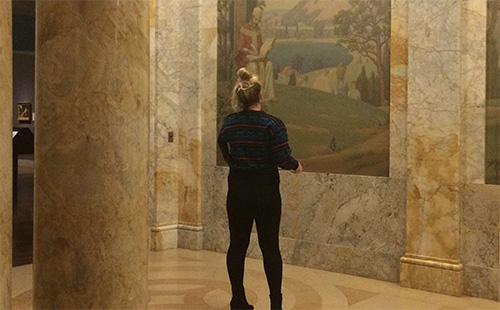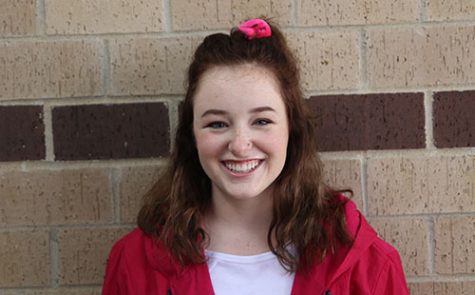Students visit “Through the Eyes of Picasso” exhibit at the Nelson-Atkins Museum of Art

Senior Allison Coy looks at a wall mural on the art field trip to the Nelson-Akins Museum of Art.
De Soto High School students in Art II, Game Design and AP Studio Art left their first block classes early on Nov. 17 to attend the Nelson-Atkins Museum of Art on a field trip to visit the “Through the Eyes of Picasso” exhibit.
The exhibit showcases Pablo Picasso’s exploration of art, including pieces of his art that represent his slow separation from the normalities of realism, as well as pieces of art that inspired this journey.
Throughout the exhibit, and more heavily at the beginning, pieces of art from African and Oceanic cultures were put on the spotlight, including cultural masks, as their cultures and artworks inspired Picasso in the early 20th century.
This part of the exhibit was art teacher Tim Mispagel’s favorite.
“I personally enjoyed seeing the influence of the masks,” Mispagel said. “I never knew what inspired Picasso to do that work and to see those masks and see some of the stuff that was in his person collection, like things he handled or had around him in his studio, that was pretty amazing.”
As the exhibit went on, Picasso’s art could be seen changing into the simplified, cubist style that most people recognize him by. This style of Picasso’s went on to carve a name for himself in history as the father of cubism.
“I think [people] can relate to it because of the simplicity of the work,” Mispagel said. “Seeing abstract work like that just makes different people feel different things. It’s not like if you see a realistic drawing of a female or a male, where everything’s solved for you, whereas in some of Picasso’s works, where it’s titled “Reclining Female Nude,” not only can you not see nudity, you can hardly tell that it’s a female. I think it’s appealing to others out of curiosity and it confuses people.”
Junior Olivia Mills, a student in Art Foundations II, had a specific piece of Picasso’s that she found particularly interesting.
“My favorite piece was these two little wire figures made out of champagne bottles that were dancers,” Mills said. “I thought it was cool how he incorporated dance into one of his pieces.”
The end of the exhibit featured a unique piece with local ties to a Kansas City born photographer named David Douglas Duncan.
This part of the exhibit was art teacher Heathyr Shaw’s favorite due to these close connections.
“[David Douglas Duncan] established this amazing relationship with Picasso and he took all these cool pictures inside his studio of him drawing and painting with his kids,” Shaw said. “I just thought that was really cool.”
Picasso’s impact on art and the world is still visible today, as his innovative style broke boundaries in the art community.
“I think he became famous because he started doing things that no one had seen during that time, this break-away from the more realistic type of painting,” Shaw said. “I think so many people today find him interesting because his paintings are just really thought provoking, and I think that they’re so distinguishable from other old and famous artists.”
With a chance to see valuable, unique pieces of art created by Picasso himself, Mispagel hopes that students “were able to see how an artist can be inspired by something like tribal masks from Africa, and something like that could start a complete movement in the fine arts.”
Shaw also had hopes of what students learned.
“I hope that [students] saw that you really have to be able to have a good foundation of classical art to be able to break away from it and do things that don’t look as difficult or don’t look as realistic,” Shaw said.
Mispagel said that he wants to do another art field sometime in the future.
“I think we’re going to do our best to try to make that happen each year,” Mispagel said. “Go see a special exhibit and just expose kids to museum. Not everyone gets to have that experience.”
Mills took away a lesson of creativity from the unique exhibit.
“I think creativity is really important,” Mills said. “Showing students art could help them with their other classes, especially divergent thinking and stuff like that.”

Meet Abby Smith, the Green Pride's first Graphic Design Editor. This is Abby’s senior year, as well as her third year on staff. She has...

